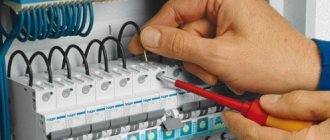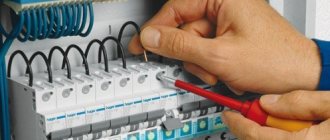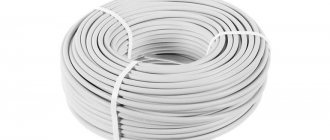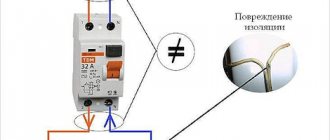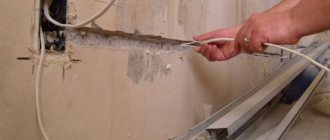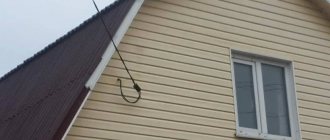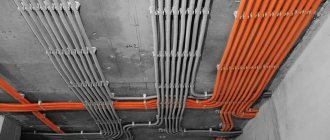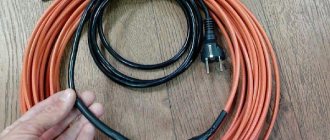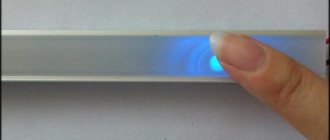When installing electrical wiring in an apartment or private house, it is very important to choose the correct wire cross-section. If you take a cable that is too thick, it will cost you a pretty penny, since its price directly depends on the diameter (section) of the conductors. The use of a thin cable leads to its overheating and if the protection does not work, the insulation may melt, a short circuit and, as a result, a fire. The most correct choice would be the wire cross-section depending on the load, which is reflected in the tables below.
Cable cross-section
The cable cross-section is the cut area of the current-carrying core. If the cut of the core is round (as in most cases) and consists of one wire, then the area/section is determined by the formula for the area of a circle. If there are many wires in the core, then the cross-section will be the sum of the cross-sections of all the wires in this core.
The cross-sectional values are standardized in all countries, and the standards of the former CIS and Europe in this part completely coincide. In our country, the document that regulates this issue is the “Rules for the Construction of Electrical Installations” or briefly - PUE.
The cable cross-section is selected based on the loads using special tables called “Permissible current loads on the cable.” If you have no desire to understand these tables, then it is enough for you to know that it is advisable to use a copper cable with a cross-section of 1.5-2.5 mm² for sockets, and 1.0-1.5 mm² for lighting.
To introduce one phase into an ordinary 2-3 room apartment, 6.0 mm² is quite enough. All the same, your 40-80 m² will not fit larger equipment, even taking into account the electric stove.
Many electricians, in order to “estimate” the required cross-section, believe that 1mm² of copper wire can pass 10A of electric current through itself: accordingly, 2.5 mm² of copper can pass 25A, and 4.0 mm² - 40A, etc. If you analyze the cable cross-section selection table a little, you will see that this method is only suitable for estimation and only for cables with a cross-section no higher than 6.0 mm².
Below is an abbreviated table for selecting cable cross-sections up to 35 mm² depending on current loads. For your convenience, the total power of electrical equipment is given there for 1-phase (220V) and 3-phase (380V) consumption.
When laying the cable in a pipe (i.e. in any closed spaces), the possible current loads on the cable should be less than when laying it openly. This is due to the fact that the cable heats up during operation, and heat transfer in a wall or in the ground is much lower than in open space.
When the load is called in kW, we are talking about the total load. Those. for a single-phase consumer, the load will be indicated for one phase, and for a three-phase consumer - in total for all three. When the load value is named in amperes (A), we are always talking about the load on one core (or phase).
Load table for cable cross-section:
| Cable cross-section, mm² | Laid open | Installed in a pipe | ||||||||||
| copper | aluminum | copper | aluminum | |||||||||
| current, A | power, kWt | current, A | power, kWt | current, A | power, kWt | current, A | power, kWt | |||||
| 220V | 380V | 220V | 380V | 220V | 380V | 220V | 380V | |||||
| 0.5 | 11 | 2.4 | ||||||||||
| 0.75 | 15 | 3.3 | ||||||||||
| 1 | 17 | 3.7 | 6.4 | 14 | 3 | 5.3 | ||||||
| 1.5 | 23 | 5 | 8.7 | 15 | 3.3 | 5.7 | ||||||
| 2.5 | 30 | 6.6 | 11 | 24 | 5.2 | 9.1 | 21 | 4.6 | 7.9 | 16 | 3.5 | 6 |
| 4 | 41 | 9 | 15 | 32 | 7 | 12 | 27 | 5.9 | 10 | 21 | 4.6 | 7.9 |
| 6 | 50 | 11 | 19 | 39 | 8.5 | 14 | 34 | 7.4 | 12 | 26 | 5.7 | 9.8 |
| 10 | 80 | 17 | 30 | 60 | 13 | 22 | 50 | 11 | 19 | 38 | 8.3 | 14 |
| 16 | 100 | 22 | 38 | 75 | 16 | 28 | 80 | 17 | 30 | 55 | 12 | 20 |
| 25 | 140 | 30 | 53 | 105 | 23 | 39 | 100 | 22 | 38 | 65 | 14 | 24 |
| 35 | 170 | 37 | 64 | 130 | 28 | 49 | 135 | 29 | 51 | 75 | 16 | 28 |
To independently calculate the required cable cross-section, for example, for entry into a house, you can use a cable calculator or select the required cross-section from the table.
This table applies to cables and wires with rubber and plastic insulation. These are such widespread brands as: PVS, GDP, VPP, PPV, APPV, VVG. AVVG and a number of others. Paper-insulated cables have their own table, and non-insulated wires and buses have their own.
When calculating the cable cross-section, the specialist must also take into account the methods of laying the cable: in trays, in bundles, etc.
- In addition, the values from the tables on permissible current loads must be adjusted by the following reduction factors:
- correction factor corresponding to the cable cross-section and its location in the block;
- correction factor for ambient temperature;
- correction factor for cables laid in the ground;
- correction factor for different numbers of operating cables laid nearby.
Aluminum cable with sector conductors
Cable type : Segment cross-sectional area, mm2 : S35 50 70 95 120 150 185 240
Four-core segment cable type - cross-sectional area h - 7 8.2 9.6 10.8 12 13.2, as well as w - 10 12 14.1 16 18 18
Three-core segment stranded 6(10) - h 6 7 9 10 11 12 13.2 15.2, as well as w 10 12 14 16 18 20 22 25
Three-core segment single-wire , 6(10) - h 5.5 6.4 7.6 9 10.1 11.3 12.5 14.4, as well as w 9.2 10.5 12.5 15 16.6 18.4 20.7 23.8
These are indications where the name of the cable type is on the left, and on the right opposite it is the cross-sectional area of the segment. Where the size (height, width) of the cable takes on the corresponding cross-sectional area. Initially, it is necessary to measure the height and width of the required segment with a ruler, after which the required parameter can be calculated by correlating the obtained data.
Aluminum cable with sector conductors
When choosing a cable, you must be guided by several criteria:
- the strength of the electric current that the cable will pass;
- power consumed by energy sources;
- current load exerted on the cable.
Calculation of wire cross-section
Let's start not with a table, but with a calculation. That is, each person, without having the Internet at hand, where the PUE with tables is freely available, can independently determine the cable cross-section by current. To do this you will need a caliper and a formula.
If we consider the cross-section of the cable, it is a circle with a certain diameter. There is a formula for the area of a circle: S = 3.14*D²/4, where 3.14 is the Archimedean number, “D” is the diameter of the measured core. The formula can be simplified: S=0.785*D².
If the wire consists of several cores, then the diameter of each is measured, the area is calculated, then all the indicators are summed up. How to calculate the cross-section of a cable if each core consists of several thin wires?
The process becomes a little more complicated, but not much. To do this, you will have to count the number of wires in one core, measure the diameter of one wire, calculate its area using the described formula and multiply this figure by the number of wires. This will be the cross section of one core. Now you need to multiply this value by the number of cores.
If you don’t want to count the wires and measure their sizes, you just need to measure the diameter of one core, consisting of several wires. You must take measurements carefully so as not to crush the core. Please note that this diameter is not exact because there is space between the wires.
Relation between current and cross section
To understand how an electrical cable works, you need to remember a regular water pipe. The larger its diameter, the more water will pass through it. It's the same with wires.
The larger their area, the greater the current that will pass through them, the greater the load such a wire can withstand. In this case, the cable will not overheat, which is the most important requirement of fire safety rules.
Therefore, the cross-section - current connection is the main criterion that is used in the selection of electrical wires in the wiring. Therefore, you need to first figure out how many household appliances and what total power will be connected to each loop.
| Wire core cross-section, mm2 | Copper conductors | Aluminum conductors | ||
| Current, A | Power, W | Current, A | Power, W | |
| 0.5 | 6 | 1300 | ||
| 0.75 | 10 | 2200 | ||
| 1 | 14 | 3100 | ||
| 1.5 | 15 | 3300 | 10 | 2200 |
| 2 | 19 | 4200 | 14 | 3100 |
| 2.5 | 21 | 4600 | 16 | 3500 |
| 4 | 27 | 5900 | 21 | 4600 |
| 6 | 34 | 7500 | 26 | 5700 |
| 10 | 50 | 11000 | 38 | 8400 |
| 16 | 80 | 17600 | 55 | 12100 |
| 25 | 100 | 22000 | 65 | 14300 |
For example, the kitchen must have a refrigerator, microwave, coffee grinder and coffee maker, an electric kettle and sometimes a dishwasher. That is, all these devices can be turned on simultaneously at the same time. Therefore, the total power of the room is used in the calculations.
You can find out the power consumption of each device from the product passport or on the tag.
- For example, let's designate some of them:
- Kettle – 1-2 kW.
- Microwave and meat grinder 1.5-2.2 kW.
- Coffee grinder and coffee maker – 0.5-1.5 kW.
- Refrigerator 0.8 kW.
Having found out the power that will act on the wiring, you can select its cross-section from the table. We will not consider all the indicators in this table; we will show those that prevail in everyday life.
Determining diameter using a ruler
The option is probably the simplest. But the accuracy of such measurements leaves much to be desired. Based on the fact that it is almost impossible to determine the diameter of a too thin wire by measuring with a ruler, this method is acceptable for relatively thick wires.
For these purposes, paper or thread is used. The whole point of the measuring process comes down to wrapping a piece of thin paper (or thread) around the wire being measured so that the ends of this piece of paper (or thread) meet. The place where the different ends of the paper come into contact is marked, after which it is removed and measured with a ruler. So, you get the circumference, which you subsequently substitute into the formula and find out the desired value.
D=L/2π,
where: D – diameter, L – circumference, π – constant value equal to 3.14.
Having information about the diameter, you can substitute it into the appropriate formula and find out the cross-sectional area.
What is the difference between a cable and a wire?
Before moving on to the main content, we need to understand what we still want to calculate, the cross-section of a wire or cable, what are the differences between one and the other!? Despite the fact that the average person uses these two words as synonyms, meaning by this something of their own, but if we are meticulous, there is still a difference.
So a wire is one conductive core, be it a single core or a set of conductors, insulated into a dielectric, into a sheath. But a cable is already several such wires combined into a single whole, in its own protective and insulating sheath. In order for you to better understand what's what, take a look at the picture.
So, now we know that we need to calculate exactly the cross-section of the wire, that is, one conductive element, and the second will already move away from the load, back to the power supply.
However, sometimes we ourselves forget ourselves no better than you, so if you catch us by the fact that somewhere you still come across the word cable, then do not consider it ignorance, stereotypes do their job.
Dependence of the area of an electrical wire on its length
Typically, the wire cross-section is calculated based on power and length. That is, the longer the wiring, the greater the power loss due to the fact that the metal wire has resistance. And it increases as the cable length increases.
Since in private houses the electrical wiring loops are not so long, this calculation can be neglected. In industry, everything is different; the dependence of cable length and cross-section through power losses is obvious. Therefore, for information, let’s consider this calculation for a single-phase network.
Cable selection
It is best to make internal wiring using copper wires. Although aluminum ones are not inferior to them. But there is one nuance here, which is associated with the correct connection of sections in the distribution box. As practice shows, connections often fail due to oxidation of the aluminum wire.
Another question is which wire to choose: single-core or stranded? Single-core has better current conductivity, so it is recommended for use in household electrical wiring. Multicore has high flexibility, which allows it to be bent in one place several times without compromising quality.
Single or stranded
When installing electrical wiring, wires and cables of the PVS, VVGng, PPV, APPV brands are usually used. This list contains both flexible cables and monocore cables.
Here we would like to tell you one thing. If your wiring will not move, that is, it is not an extension cord, or a bend point that constantly changes its position, then it is preferable to use a monocore.
You will ask why? It's simple! No matter how well the conductors are laid in the protective insulating braid, air containing oxygen will still get under it. Oxidation of the copper surface occurs.
As a result, if there are many conductors, then the oxidation area is much larger, which means the current-carrying cross-section “melts” much more. Yes, this is a long process, but we don’t think that you are going to change the wiring often. The more she works, the better.
This oxidation effect will be especially pronounced at the edges of the cable cut, in rooms with temperature changes and high humidity. So we strongly recommend that you use monocore! The cross-section of a monocore cable or wire will change slightly over time, and this is so important for our further calculations.
Copper or aluminum
In the USSR, most residential buildings were equipped with aluminum wiring; this was a kind of norm, standard, and even dogma. No, this does not mean at all that the country was poor and there was a shortage of copper. Even in some cases it's the other way around.
But apparently the designers of electrical networks decided that they could save a lot economically if they used aluminum rather than copper. Indeed, the pace of construction was enormous; just remember the Khrushchev buildings, in which half of the country still lives, which means the effect of such savings was significant. There is no doubt about this.
However, today the realities are different, and aluminum wiring is not used in new residential premises, only copper. This is based on the rules of the PUE, clause 7.1.34 “Cables and wires with copper conductors should be used in buildings...”.
So, we strongly do not recommend that you experiment and try aluminum. Its disadvantages are obvious. Aluminum strands cannot be soldered and are also very difficult to weld; as a result, the contacts in the junction boxes may break over time. Aluminum is very fragile, two or three bends and the wire falls off.
There will be constant problems connecting it to sockets and switches. Again, if we talk about conducted power, then a copper wire with the same cross-section for aluminum is 2.5 mm2. allows a continuous current of 19A, and for copper 25A. Here the difference is more than 1 kW.
So let’s repeat it again - only copper! Further, we will proceed from the fact that we are calculating the cross-section for a copper wire, but in the tables we will also give values for aluminum. You never know.
Heat transfer conditions
An important condition for heat transfer is the humid environment in which the cable is located. When placing a wire in the ground, heat removal is directly related to the structure and its composition, as well as the level of humidity.
To obtain the most accurate values, you will have to analyze the composition of the soil, depending on which the resistance will vary. Using the table, look for resistivity. Thanks to high-quality compaction, this characteristic can be reduced. Sand and gravel have lower thermal conductivity compared to clay, so ideally the wires are buried last. Instead of clay, you can use loam without admixtures of slag, stones and debris.
The heat dissipation of the air cable is minimal. The parameter decreases for lines in cable ducts that have an air gap. Cables located close to each other heat each other, so current loads should be kept as low as possible. Permissible currents are calculated using two different formulas depending on the operating mode - emergency or long-term. If a short circuit occurs, the permissible temperature for a paper-insulated wire is 200, PVC - 120 degrees Celsius.
It is important to remember the different cooling conditions for cables with and without insulation. In the first case, the heat flows emanating from the heating of the cores are forced to overcome an additional barrier in the form of an insulating layer.
Cable location in trench
When laying cables underground, when two conductors are located in one trench at once, the cooling process will slow down significantly, which will lead to a reduction in permissible current loads.
From the point of view of electrical and fire safety, determining the correct long-term permissible current and cable cross-section is an important condition to prevent overheating, insulation failure and ignition of the cable line. When making calculations, you should be careful and take into account many additional conditions. Certain adjustments are needed even for tabular values.
Why is the calculation made?
Wires and cables that carry electrical current are the most important part of electrical wiring.
The wire cross-section must be calculated to ensure that the selected wire meets all the requirements for reliability and safe operation of electrical wiring.
Safe operation is that if you choose a cross-section that does not correspond to its current loads, this will lead to excessive overheating of the wire, melting of the insulation, short circuit and fire.
Therefore, the issue of choosing a wire cross-section must be taken very seriously.
What you need to know
The main indicator by which a wire is calculated is its long-term permissible current load. Simply put, this is the amount of current that it is capable of passing for a long time.
To find the rated current value, you need to calculate the power of all connected electrical appliances in the house. Let's consider an example of calculating the wire cross-section for an ordinary two-room apartment.
Table of power/current consumption of household electrical appliances
| electrical appliance | Power consumption, W | Current strength, A |
| Washing machine | 2000 – 2500 | 9,0 – 11,4 |
| Jacuzzi | 2000 – 2500 | 9,0 – 11,4 |
| Electric floor heating | 800 – 1400 | 3,6 – 6,4 |
| Stationary electric stove | 4500 – 8500 | 20,5 – 38,6 |
| microwave | 900 – 1300 | 4,1 – 5,9 |
| Dishwasher | 2000 – 2500 | 9,0 – 11,4 |
| Freezers, refrigerators | 140 – 300 | 0,6 – 1,4 |
| Electric meat grinder | 1100 – 1200 | 5,0 – 5,5 |
| Electric kettle | 1850 – 2000 | 8,4 – 9,0 |
| Electric coffee maker | 630 – 1200 | 3,0 – 5,5 |
| Juicer | 240 – 360 | 1,1 – 1,6 |
| Toaster | 640 – 1100 | 2,9 – 5,0 |
| Mixer | 250 – 400 | 1,1 – 1,8 |
| Hairdryer | 400 – 1600 | 1,8 – 7,3 |
| Iron | 900 –1700 | 4,1 – 7,7 |
| Vacuum cleaner | 680 – 1400 | 3,1 – 6,4 |
| Fan | 250 – 400 | 1,0 – 1,8 |
| TV | 125 – 180 | 0,6 – 0,8 |
| Radio equipment | 70 – 100 | 0,3 – 0,5 |
| Lighting devices | 20 – 100 | 0,1 – 0,4 |
Once the power is known, the calculation of the cross-section of a wire or cable comes down to determining the current strength based on this power. You can find the current strength using the formula:
1) Formula for calculating current for a single-phase 220 V network:
current calculation for a single-phase network
where P is the total power of all electrical appliances, W; U—mains voltage, V; CI = 0.75 - simultaneity coefficient; cos for household electrical appliances - for household electrical appliances. 2) Formula for calculating the current in a three-phase 380 V network:
current calculation for a three-phase network
Knowing the magnitude of the current, the wire cross-section is found from the table. If it turns out that the calculated and tabulated current values do not coincide, then in this case the nearest larger value is selected. For example, the calculated current value is 23 A, we select the nearest larger one from the table, 27 A - with a cross-section of 2.5 mm2.
Which wire is better to use
Today, for installation of both open and hidden electrical wiring, copper wires are, of course, very popular.
- Copper, compared to aluminum, is more effective:
- it is stronger, softer and does not break in places of inflection compared to aluminum;
- less susceptible to corrosion and oxidation. When connecting aluminum in a junction box, the twist points oxidize over time, which leads to loss of contact;
- The conductivity of copper is higher than that of aluminum; with the same cross-section, a copper wire can withstand a higher current load than aluminum.
The disadvantage of copper wires is their high cost. Their cost is 3-4 times higher than aluminum ones. Although copper wires are more expensive, they are still more common and popular in use than aluminum wires.
Power (wire diameter)
The most important parameter during electrical installation work (in particular, cable laying) is throughput. The maximum power of electricity transmitted through a conductor depends on the cross-section of that conductor itself. Therefore, it is extremely important to know the total power of the energy consumption sources that will be connected to the wire. Often, household appliances and other electrical appliances indicate the maximum and average power consumption on the label and in the accompanying documentation.
If, for example, a washing machine in the process of washing clothes can consume electricity in the range from tens of W/h during rinsing mode to 2.7 kW/h when heating water. This is a lot of power and naturally, a wire with a cross-section that is sufficient to transmit electricity of maximum power must be connected to it. In the case when two or more consumers are connected to the cable, the total power is determined by adding the limit values of each of them. The average power of all electrical appliances and lighting devices in an apartment rarely exceeds 7500 W for a single-phase network. Accordingly, the cable cross-sections in the electrical wiring must be selected to this value.
For example, for a total power value of 7.5 kW, it is necessary to use a copper cable with a core cross-section of 4 mm2, which is capable of transmitting about 8.3 kW. The cross-section of the conductor with an aluminum core in this case must be at least 6 mm2, passing a current power of 7.9 kW.
In some special residential buildings, a three-phase power supply system of 380 V is often used. But the fact is that most equipment is not designed for such electrical voltage. A voltage of 220 V is created by connecting them to the network through a neutral cable with an even distribution of the current load across all phases.
Calculation of the cross-section of copper wires and cables
Having calculated the load and decided on the material (copper), let’s consider an example of calculating the cross-section of wires for individual groups of consumers, using the example of a two-room apartment.
As you know, the entire load is divided into two groups: power and lighting.
In our case, the main power load will be the socket group installed in the kitchen and bathroom. Since the most powerful equipment is installed there (electric kettle, microwave, refrigerator, boiler, washing machine, etc.).
For this socket group we select a wire with a cross section of 2.5mm2. Provided that the power load will be scattered across different outlets. What does it mean? For example, in the kitchen, to connect all household appliances, you need 3-4 sockets connected with copper wire with a cross-section of 2.5 mm2 each.
If all equipment is connected through one single socket, then a cross-section of 2.5 mm2 will not be enough, in this case you need to use a wire with a cross-section of 4-6 mm2. In living rooms, a wire with a cross section of 1.5 mm2 can be used to power sockets, but the final choice must be made after appropriate calculations.
The entire lighting load is powered by a wire with a cross section of 1.5 mm2.
It is necessary to understand that the power in different sections of the electrical wiring will be different, and accordingly the cross-section of the supply wires will also be different. Its greatest value will be in the introductory section of the apartment, since the entire load passes through it. The cross-section of the input supply wire is selected 4 - 6 mm2.
When installing electrical wiring, wires and cables of the PVS, VVGng, PPV, APPV brands are used.
Selection of cable cross-section by power
Now we get to the essence of our article. However, everything that was above cannot be missed, which means we could not remain silent.
If we try to present the idea logically and simply, then a current of a certain strength can pass through each conventional cross-section of a conductor. This conclusion is quite logical and now all that remains is to find out these ratios and correlate them for different wire diameters, based on its type series.
It also cannot be ignored that here, when calculating the current cross section, temperature also comes into play. Yes, this is a new component – temperature. It is she who can influence the cross section. How and why, let's figure it out.
We all know about Brownian motion. On the constant displacement of ions in a crystal lattice. All this happens in all materials, including conductors. The higher the temperature, the greater these vibrations of ions within the material will be. And we know that current is the directed movement of particles.
So, the directed movement of particles will collide with ions in the crystal lattice, which will lead to an increase in resistance to current.
The higher the temperature, the higher the electrical resistance of the conductor. Therefore, by default, the wire cross-section for a certain current is taken at room temperature, that is, at 18 degrees Celsius. It is at this temperature that all reference values are given in the tables, including ours.
Despite the fact that we do not consider aluminum wires as wires for electrical wiring, at least in an apartment, they are nevertheless used in many places. Let's say for wiring on the street. That is why we will also present the values of the cross-section and current dependencies for aluminum wires.
So, for copper and aluminum there will be the following indicators of the dependence of the cross-section of the wire (cable) on the current (power). See table.
Table of conductors for maximum permissible current for their use in wiring:
Since 2001, aluminum wires have not been used for wiring in apartments. (PEU)
Yes, here, as our reader noted, we actually did not provide calculations, but only provided reference data, tabulated, based on these calculations. But we dare to tell you that for calculations it is necessary to go through many formulas and indicators. Starting from temperature, resistivity, current density and the like.
Therefore, we will leave such calculations for specialists. It should be noted that they are not final, since they may vary slightly depending on the standard for the material and the current reserve of the wire used in different countries.
But what we would also like to talk about is converting the wire cross-section to diameter. This is necessary when there is a wire, but for some reason there is no marking on it. In this case, the cross-section can be calculated from the diameter of the wire, and vice versa from the diameter of the cross-section.
Determining diameter using a micrometer
Calculating the diameter of a wire is the simplest thing that can be done not only by a novice in installing electrical wiring, but even by a person who has nothing to do with this area. To measure the diameter, simply use one of the most common methods.
The first method is to use a micrometer or caliper. This method is considered the most relevant and often used in practice. This is due to the fact that such devices provide the most accurate measurement indicators. The measurement process itself is carried out by moving the latch to the open position. The micrometer handle must be unscrewed to a distance that will allow the wire to easily fit into the groove between the probes. After this, the handles of the device are activated: they twist the device until the ratchet operates. That's all, you can record the received data.
Common cross-sections for wiring in an apartment
We talked a lot about names, materials, individual characteristics and even temperature, but we lost sight of life circumstances.
So, if you hire an electrician to conduct wiring in the rooms of your apartment or house, then the following values are usually accepted. For lighting, the wire cross-section is taken at 1.5 mm 2, and for sockets at 2.5 mm 2.
If the wiring is intended for connecting boilers, heaters, stoves, then the cross-section of the wire (cable) is already calculated individually.
Determining the diameter using a pen or pencil
This method is based on the understanding that the diameter of the wire along its entire length is invariably the same. You simply take a pen or pencil and wrap the conductor around it, neatly forming turn after turn, like a spiral, one after the other. Since the insulation produces errors, it must be cut along the entire length of the formed turns. Remember about the maximum density of pressing the turns against each other - this will provide you with more accurate output data.
Since all the turns have the same thickness, to find out the diameter you need to measure the length of the winding you formed on the handle and divide it by the number of turns you received. For example, if your winding of 15 turns is 1.5 cm, this means that the diameter of the wire you took for calculation is 1 mm. It's quite simple.
Selecting the wire cross-section based on the number of consumers
What I also wanted to say is that it is better to use several independent power lines for each room in a room or apartment. Thus, you will not use a wire with a cross-section of 10 mm 2 for the entire apartment, routed to all rooms, from which there are taps.
Such a wire will come to the input machine, and then from it, in accordance with the power of the consumed load, selected wire sections will be routed for each of the rooms.
Typical electrical wiring diagram for an apartment or house with an electric stove (indicating the cable cross-section for electrical appliances)
conclusions
Before wiring your home, be sure to familiarize yourself with the existing types of wires. Electricians also recommend examining copper wire for color before purchasing, since manufacturers can save on material and use an alloy. This contributes to a significant increase in electrical resistance, which, in turn, does not allow the use of the permissible load level for a particular section.
Experts also advise measuring only the core when making calculations. No matter how thin the insulation on a wire is, no matter how flexible it is, you will have to remove it one way or another to get accurate data. Otherwise, the extra millimeters will give you a reason to use an unacceptably small cross-section of wire for wiring, the load for which will ultimately be excessive. This, in turn, is fraught with consequences.
Current loads in DC networks
In networks with direct current, the cross section is calculated somewhat differently. The resistance of a conductor to direct voltage is much higher than to alternating current (with alternating current, resistance at lengths of up to 100 m is generally neglected).
In addition, for DC consumers, as a rule, it is very important that the voltage at the ends is not lower than 0.5V (for AC consumers, as is known, voltage fluctuations within 10% in any direction are acceptable).
There is a formula that determines how much the voltage at the ends will drop compared to the base voltage, depending on the length of the conductor, its resistivity and the current in the circuit:
U = ((pl)/S)I
- Where:
- U—DC voltage, V
- p—wire resistivity, Ohm*mm2/m
- l — wire length, m
- S - cross-sectional area, mm2
- I - current strength, A
Knowing the values of these indicators, it is quite easy to calculate the cross section you need: by substitution method, or using simple arithmetic operations on this equation.
If the DC voltage drop at the ends does not matter, then to select the cross-section you can use the table for alternating current, but at the same time adjust the current values by 15% towards a decrease, i.e. with direct current, reference cable cross-sections can carry 15% less current than indicated in the table.
A similar rule also works for selecting circuit breakers for networks with direct current, for example: for circuits with a load of 25A, you need to take a circuit breaker with a 15% lower rating; in our case, the previous standard size of the circuit breaker is suitable - 20A.
The cable that transmits electric current is one of the most important elements of the electrical network. If the cable fails, the operation of the entire system becomes impossible, therefore, to prevent failures, as well as the risk of fire from overheating, an accurate calculation of the cable cross-section for the load should be made.
This calculation gives confidence in the safe and reliable operation of the network and devices, but more importantly, the safety of people.
Choosing a cross-section that is insufficient for the current load leads to overheating, melting and damage to the insulation, and this, in turn, leads to a short circuit and even a fire. So there are many reasons to carry out calculations and carefully select the appropriate cable.
What is needed for load calculations
The main indicator that helps calculate the cross-section and brand of cable is the maximum permissible continuous load (current). To put it simply, this is the amount of current that the cable is capable of passing under the conditions of its installation without overheating for a sufficiently long time.
This requires a simple arithmetic summation of the powers of all electrical appliances that will be connected to the network.
The next important step to achieve safety is to calculate the cable cross-section for the load, for which it is necessary to calculate the current strength using the formula:
For a single-phase 220 V network:
- Where:
- P is the total power for all electrical appliances, W;
- U—mains voltage, V;
- COSφ - power factor.
For a three-phase network with a voltage of 380 V:
| Device name | Approximate power, W |
| LCD TV | 140-300 |
| Fridge | 300-800 |
| Vacuum cleaner | 800-2000 |
| Computer | 300-800 |
| Electric kettle | 1000-2000 |
| Air conditioner | 1000-3000 |
| Lighting | 300-1500 |
| Microwave | 1500-2200 |
Having received the exact current value, you should refer to tables that allow you to find a cable or wire of the required cross-section and material. But if the obtained current value does not exactly coincide with the table value, then you should not “save”, but rather choose the nearest, but larger value of the cable cross-section.
Example: with a network voltage of 220 V, the resulting current value was 22 amperes, the nearest larger value (27 A) is a copper wire or copper cable with a cross-section of 2.5 mm square. This means that the optimal choice would be just such a cable, and not with a cross-section of 1.5 mm square, which has a permissible continuous current of 19 A.
| Cross-section of current-carrying conductors, mm | Copper conductors of wires and cables | |||
| Voltage 220V | Voltage 380V | |||
| Current, A | power, kWt | Current, A | power, kWt | |
| 1,5 | 19 | 4,1 | 16 | 10,5 |
| 2,5 | 27 | 5,9 | 25 | 16,5 |
| 4 | 38 | 8,3 | 30 | 19,8 |
| 6 | 46 | 10,1 | 40 | 26,4 |
| 10 | 70 | 15,4 | 50 | 33 |
| 16 | 85 | 18,7 | 75 | 49,5 |
| 25 | 115 | 25,3 | 90 | 59,4 |
| 35 | 135 | 29,7 | 115 | 75,9 |
| 50 | 175 | 38,5 | 145 | 95,7 |
| 70 | 215 | 47,3 | 180 | 118,8 |
| 95 | 260 | 57,2 | 220 | 145,2 |
| 120 | 300 | 66 | 260 | 171,6 |
If you choose a cable with aluminum cores, then it is better to take a core cross-section of 4 mm square rather than 2.5.
| Cross-section of current-carrying conductors, mm | Aluminum conductors of wires and cables | |||
| Voltage 220V | Voltage 380V | |||
| Current, A | power, kWt | Current, A | power, kWt | |
| 2,5 | 20 | 4,4 | 19 | 12,5 |
| 4 | 28 | 6,1 | 23 | 15,1 |
| 6 | 36 | 7,9 | 30 | 19,8 |
| 10 | 50 | 11 | 39 | 25,7 |
| 16 | 60 | 13,2 | 55 | 36,3 |
| 25 | 85 | 18,7 | 70 | 46,2 |
| 35 | 100 | 22 | 85 | 56,1 |
| 50 | 135 | 29,7 | 110 | 72,6 |
| 70 | 165 | 36,3 | 140 | 92,4 |
| 95 | 200 | 44 | 170 | 112,2 |
| 120 | 230 | 50,6 | 200 | 132 |
Load (wire diameter)
Calculation of the cross-section of cable products based on current load must be carried out to further protect them from overheating. If too much electric current passes through the conductors for their cross-section, destruction and melting of the insulating layer may occur. The maximum permissible long-term current load is the quantitative value of the electric current that can pass the cable for a long time without overheating. It's important to know this. To determine this indicator, it is initially necessary to sum up the powers of all energy consumers. After this, calculate the load using the formulas:
I = P∑*Ki/U (single-phase network),
I = P∑*Kи/(√3*U) (three-phase network),
Where:
- P∑ – total power of energy consumers;
- Ki – coefficient equal to 0.75;
- U – electrical voltage in the network.
Parallel connection of electrical wiring wires
There are hopeless situations when you urgently need to lay wiring, but there is no wire of the required cross-section available. In this case, if there is a wire with a smaller cross-section than necessary, then the wiring can be made from two or more wires, connecting them in parallel. The main thing is that the sum of the sections of each of them is not less than the calculated one.
For example, there are three wires with a cross section of 2, 3 and 5 mm2, but according to calculations, 10 mm2 is needed. Connect them all in parallel and the wiring will handle up to 50 amps. Yes, you yourself have repeatedly seen the parallel connection of a large number of thin conductors to transmit large currents.
For example, welding uses a current of up to 150 A and in order for the welder to control the electrode, a flexible wire is needed. It is made from hundreds of thin copper wires connected in parallel. In a car, the battery is also connected to the on-board network using the same flexible stranded wire, since when starting the engine, the starter consumes a current of up to 100 A from the battery.
And when installing and removing the battery, it is necessary to move the wires to the side, that is, the wire must be flexible enough. The method of increasing the cross-section of an electrical wire by connecting several wires of different diameters in parallel can be used only as a last resort. When laying home electrical wiring, it is permissible to connect in parallel only wires of the same cross-section taken from the same reel.
Author: Sergey Vladimirovich, electrical engineer. More about the author.
What brand of cable is best to use to connect the motor?
When selecting cable brands for powering asynchronous electric motors, take into account the conditions in which they will operate. To provide power to mobile electrical installations that often move between construction sites or other work, preference should be given to flexible brands of cable products. There are a number of mechanisms driven by asynchronous electric motors, which make constant movements during operation. For example, beam cranes, electric hoists and other lifting equipment. The electric drive of such mechanisms is connected to the electrical network only with flexible copper cables with rubber insulation. The current cores of flexible cables are assembled with bundles of thin copper wire, so they can withstand repeated bending.
The most suitable and popular brands for such engines are KG, KPGS, KPG1U
For installation in the ground, it is advisable to choose an armored cable (for example, VBShv or AVBShv) to exclude the possibility of accidental damage in hard ground. It is allowed to lay PVC-sheathed cables in trenches with a sand cushion. These types of cables can also be laid in trays.
Methods for measuring conductor diameter
When selecting an electrical cable or wire to check the cross-section of the core, it is necessary to measure its diameter. There are several ways to do this. You can use measuring instruments such as calipers or micrometers. They measure the size of the exposed part of the conductor.
The device is simply attached to the core, clamped between the jaws, and the result is displayed on the scale. For private use, the measurements are quite accurate, with a small error. Especially if the devices are electronic.
For the second method, you only need a ruler and some kind of even rod. But in this case, you still have to do calculations, albeit very simple ones. More on this method later.
Ruler+rod
If there are no measuring instruments on the farm, you can get by with a regular ruler and any rod of the same diameter. This method has a high error, but if you try it will be quite accurate. Take a piece of wire about 10-20 cm long and remove the insulation.
We wind the bare copper or aluminum wire onto a rod of the same diameter (any screwdriver, pencil, pen, etc. will do). We lay the coils carefully, close to one another. The number of turns is 5-10-15. We count the number of full turns, take a ruler and measure the distance that the wound wire occupies on the rod. Then divide this distance by the number of turns. As a result, we obtain the diameter of the conductor.
For example, we wound 10 turns (it’s easier to count), they took up 3.8 cm (or 38 mm) on the rod. Next, we divide the distance by the number of turns, 38/10 = 3.8 mm, we get that the diameter of the wound wire is 3.8 mm.
As you can see, there is an error here. Firstly, you can lay the wire loosely. Secondly, it is not enough to take accurate measurements. But if you do everything carefully, the discrepancies with the actual sizes will not be so large.
Application of measuring instruments
To determine the diameter of the cores of wires and cables, various measuring instruments are widely used, showing the most accurate results. Basically, the use of micrometers and calipers is practiced for these purposes. Despite their high efficiency, a significant drawback of these devices is their high cost, which is of great importance if the tool is planned to be used only 1-2 times.
As a rule, professional electricians who are constantly engaged in electrical installation work use special devices. With the right approach, it becomes possible to measure the diameter of wire cores even on working lines.
